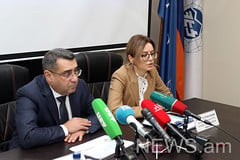
The experts of an International Atomic Energy Agency (IAEA) said Armenia has made progress in strengthening its regulatory framework for nuclear and radiation safety but still faces challenges, including a shortage of qualified and experienced staff at the regulatory body, the official website of IAEA reported.
The Integrated Regulatory Review Service (IRRS) team on 17 June concluded a seven-day follow-up mission to review Armenia’s implementation of recommendations and suggestions made during an initial IRRS mission in 2015. The follow-up mission was conducted at the request of the Government of Armenia and hosted by the Armenia Nuclear Regulatory Authority (ANRA).
According to the source, the Armenian Nuclear Power Plant (ANPP) in Metsamor provides 40% of the country’s electricity. ANPP’s Unit 1 was permanently shut down in 1989, while the operating license for Unit 2 has been extended until 2021 subject to yearly safety demonstrations, with preparations under way for requesting an additional extension until 2026. Armenia also has a dry spent fuel storage facility, a radioactive waste storage facility, and uses radioactive sources in medicine, industry and research.
“Armenia has made substantial progress in developing a policy and a strategy for safety. However, the regulator faces a critical situation related to human resources. ANRA and its technical and support organization, the Nuclear and Radiation Safety Centre (NRSC), are not financially competitive compared with the industry and ANPP. There is an urgent need to address this issue,” said IRRS team leader Hans Wanner, who is Director General of the Swiss Federal Nuclear Safety Inspectorate.
The team found that Armenia since 2015 has taken key steps forward by adopting a strategy for spent fuel and radioactive waste management, and by intensifying inspections related to emergency preparedness and response.
The team acknowledged that ANRA faces many challenges in regulating nuclear safety, including implementation of findings related to a European Union initiative on conducting nuclear power plant stress tests. The initiative, which Armenia has joined, stems from lessons learned from the 2011 Fukushima Daiichi accident in Japan.
“The findings of the IRRS follow-up mission help ANRA to make decisions towards further improvement of the national regulatory framework for safety, in line with IAEA safety standards,” said Ashot Martirosyan, ANRA chairman. “To cope with this task ANRA should first resolve the staffing problem as confirmed by the IRRS team. Measures are already under way to resolve this issue, which is also in the focus of Armenia’s leadership.”
“In light of ongoing challenges associated with the long-term operation of the Armenia Nuclear Power Plant, the findings made by the IRRS mission to improve regulatory infrastructure for safety are very timely,” said Greg Rzentkowski, Director of the IAEA’s Division of Nuclear Installation Safety.
The 12-member IRRS team comprised senior regulatory experts from Argentina, Bulgaria, Czech Republic, Egypt, Germany, Romania, Switzerland, Ukraine and the United States of America as well as three IAEA staff members.
The final mission report will be provided to the Government in about three months. The Government plans to make the report public.






















